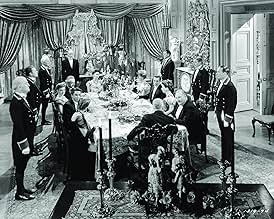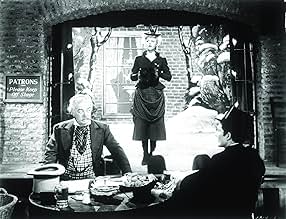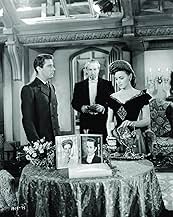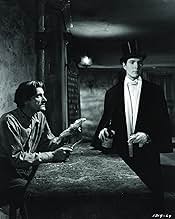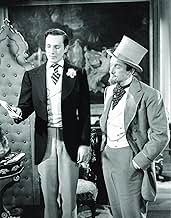NOTE IMDb
7,5/10
15 k
MA NOTE
Un jeune homme corrompu parvient curieusement à garder sa beauté juvénile, mais un tableau spécial révèle progressivement sa laideur intérieure.Un jeune homme corrompu parvient curieusement à garder sa beauté juvénile, mais un tableau spécial révèle progressivement sa laideur intérieure.Un jeune homme corrompu parvient curieusement à garder sa beauté juvénile, mais un tableau spécial révèle progressivement sa laideur intérieure.
- Réalisation
- Scénario
- Casting principal
- Récompensé par 1 Oscar
- 3 victoires et 4 nominations au total
Renee Carson
- Young French Woman
- (as Renie Carson)
Lilian Bond
- Kate
- (as Lillian Bond)
Devi Dja
- Lead Dancer
- (as Devi Dja and Her Balinese Dancers)
Avis à la une
This wonderfully atmospheric retelling of Oscar Wilde's chilling novel is one of the best horror films ever made. It outdoes DRACULA and FRANKENSTEIN because it is about a man -- not a monster. Yet the monster IS the man -- and hides within all of us. The story works even more effectively than the similar plot in Robert Louis Stevenson's STRANGE CASE OF DR. JEKYLL AND MR HYDE because here we have the dual sides of a man portrayed not as two separate characters but as two reflecting images -- like two mirrors facing each other, sending the images out to infinity. The painting itself is one of the most horrifing images ever created in films -- a surreal reflection of what each of us can become if we lose our humanity and replace it with careless egotism.
It is a mystery. Or is it mind over matter? The power of a mysterious painting depicted in this timeless tale of Oscar Wilde's imagination -- probing the depth of life's meaning.
It's costume drama, story began in London 1886. Definitely has an element of intrigue -- "a painting with a life of its own". It's eerie. It's dramatic. Its theme is scary. Such is a "deadly" wish of the main character, Dorian Gray: "If only the picture (a portrait of Dorian Gray) can change, and I can always be as I am now. I'd give my soul for that." Dorian Gray's obsession with youth became eternal youth.
Imagine that as time goes by, he will always stay the same rich attractive young man that he is -- never grow old, while the picture will take on the changes -- his soul and character. Conscience, no longer he has -- the picture took it on. The story describes how Dorian Gray spends his life henceforth and the consequences that entail.
A very young Angela Lansbury, after her debut in George Cuckor's 1944 "Gaslight", portrays the innocent young actress Sibyl Vane from the poor side of town. The bet between the characters of George Sanders and Hurd Hatfield brought to mind the cruel intentions of Neil LaBute's 1997 "In the Company of Men". George Sanders is the cynical callous Lord Henry Wotton. The events all happen in a seemingly civil manner, immersed in the society of the rich. Have and have-nots are juxtaposed.
The film is essentially in Black and White, with only the specific content of the picture of Dorian Gray in color when we see it through Dorian's eyes.
It's another B/W classics gem, well-cut and impeccably presented. It encompasses sentiments and all elements: mystery, intrigue, love lost, friendships, regrets, and fear. Dorian Gray with a tormented inside -- pining for the return of his soul. Is this the Devil's advocate? You see no hell depicted as in Vincent Ward's 1998 "What Dreams May Come", or Woody Allen's 1997 "Deconstructing Harry" or Taylor Hackford's 1998 "The Devil's Advocate". No glamorous, elaborate take on the Devil, but the atmosphere provided that suggestion. There's no special effects, yet you can feel the twistedness: a man asking for help within yet unable to help himself because he's a lost soul. The temperature of the movie seems like being in 10 degree Celsius -- cold in sentiment and tone. There was a glimmer of warmth -- it flickered and faded with the innocent Sibyl Vane character.
The subject matter is timeless even though the film was made in 1945. The story is fascinating in spite of the pace which may not be at breakneck speed as in today's action packed, sound effects filled movies.
You can say it's pseudo sci-fi -- a foreboding tale it is. By and by, Dorian Gray's unchanging mask-like face reminds me of "Mr. Sardonicus" (William Castle's 1961). His behaviors are no longer placid -- gradually turning into hideous evils. This film questions one's probity. The mystery of life is to live it not to attain immortality. How uninteresting it'd be to be changeless and ageless? (John Boorman's 1974 sci-fi "Zardoz" with Sean Connery and Charlotte Rampling came to mind). Growth and change are intrinsic elements of life. Life and death go hand in hand cyclically. A truly worthwhile effort from writer/director Albert Lewin.
It's costume drama, story began in London 1886. Definitely has an element of intrigue -- "a painting with a life of its own". It's eerie. It's dramatic. Its theme is scary. Such is a "deadly" wish of the main character, Dorian Gray: "If only the picture (a portrait of Dorian Gray) can change, and I can always be as I am now. I'd give my soul for that." Dorian Gray's obsession with youth became eternal youth.
Imagine that as time goes by, he will always stay the same rich attractive young man that he is -- never grow old, while the picture will take on the changes -- his soul and character. Conscience, no longer he has -- the picture took it on. The story describes how Dorian Gray spends his life henceforth and the consequences that entail.
A very young Angela Lansbury, after her debut in George Cuckor's 1944 "Gaslight", portrays the innocent young actress Sibyl Vane from the poor side of town. The bet between the characters of George Sanders and Hurd Hatfield brought to mind the cruel intentions of Neil LaBute's 1997 "In the Company of Men". George Sanders is the cynical callous Lord Henry Wotton. The events all happen in a seemingly civil manner, immersed in the society of the rich. Have and have-nots are juxtaposed.
The film is essentially in Black and White, with only the specific content of the picture of Dorian Gray in color when we see it through Dorian's eyes.
It's another B/W classics gem, well-cut and impeccably presented. It encompasses sentiments and all elements: mystery, intrigue, love lost, friendships, regrets, and fear. Dorian Gray with a tormented inside -- pining for the return of his soul. Is this the Devil's advocate? You see no hell depicted as in Vincent Ward's 1998 "What Dreams May Come", or Woody Allen's 1997 "Deconstructing Harry" or Taylor Hackford's 1998 "The Devil's Advocate". No glamorous, elaborate take on the Devil, but the atmosphere provided that suggestion. There's no special effects, yet you can feel the twistedness: a man asking for help within yet unable to help himself because he's a lost soul. The temperature of the movie seems like being in 10 degree Celsius -- cold in sentiment and tone. There was a glimmer of warmth -- it flickered and faded with the innocent Sibyl Vane character.
The subject matter is timeless even though the film was made in 1945. The story is fascinating in spite of the pace which may not be at breakneck speed as in today's action packed, sound effects filled movies.
You can say it's pseudo sci-fi -- a foreboding tale it is. By and by, Dorian Gray's unchanging mask-like face reminds me of "Mr. Sardonicus" (William Castle's 1961). His behaviors are no longer placid -- gradually turning into hideous evils. This film questions one's probity. The mystery of life is to live it not to attain immortality. How uninteresting it'd be to be changeless and ageless? (John Boorman's 1974 sci-fi "Zardoz" with Sean Connery and Charlotte Rampling came to mind). Growth and change are intrinsic elements of life. Life and death go hand in hand cyclically. A truly worthwhile effort from writer/director Albert Lewin.
It's hard to say what it is about "The Picture of Dorian Gray" that I enjoyed so much, but I did like it. Hurd Hatfield at first seems miscast and ineffective as the titular character, but somewhere around the one hour mark, his one and only expression begins to grow on you until you feel just as unnerved by his presence as those who come in contact with him in the story. George Sanders--from what I've seen--played one character his enter career but played it so well, and his performance in this film is no exception. Angela Lansbury is surprisingly sympathetic as the sad and timid singer. The only one in the cast who really doesn't work is Donna Reed. Her character feels tacked on, and she isn't allowed to do much but look faithful and beautiful.
The film is shot wonderfully, and Harry Stradling's cinematography gives the East End scenes a dark, atmospheric counter balance to the rather plain and flat interiors of Dorian's home. The swinging lamp was a nice touch and reminded me of "Psycho"'s finale.
I suppose my only criticism is toward the end, the story introduced one or two characters without giving them proper context or background (I'm thinking of the Allen Campbell character). I'm assuming Dorian "convinces" him to take part in his plans because of some sort past homosexual tryst, but it seemed unfair to bring him in they way he was, have him serve the role he does, and then disappear so quickly without explanation. And speaking of suggested themes: Is it just me, or could you make an argument that Dorian is Jack the Ripper? Maybe it's actually pretty obvious or maybe I'm just interpreting too much into the story, but that's what I got out of it.
P.S. I had the opportunity to see the actual painting from the film during an Ivan Albright exhibit at the Metropolitan Museum of Art in 1997. It's even more gruesome in person.
The film is shot wonderfully, and Harry Stradling's cinematography gives the East End scenes a dark, atmospheric counter balance to the rather plain and flat interiors of Dorian's home. The swinging lamp was a nice touch and reminded me of "Psycho"'s finale.
I suppose my only criticism is toward the end, the story introduced one or two characters without giving them proper context or background (I'm thinking of the Allen Campbell character). I'm assuming Dorian "convinces" him to take part in his plans because of some sort past homosexual tryst, but it seemed unfair to bring him in they way he was, have him serve the role he does, and then disappear so quickly without explanation. And speaking of suggested themes: Is it just me, or could you make an argument that Dorian is Jack the Ripper? Maybe it's actually pretty obvious or maybe I'm just interpreting too much into the story, but that's what I got out of it.
P.S. I had the opportunity to see the actual painting from the film during an Ivan Albright exhibit at the Metropolitan Museum of Art in 1997. It's even more gruesome in person.
One of my personal favorites of films of the '40s is this visually striking version raising the art of black-and-white photography to new heights. The sets and costumes and deep-focus photography combine to make even more absorbing the story Oscar Wilde tells of the man whose portrait decays as he himself remains forever youthful. Hurd Hatfield never had a better role and he makes the most of it. George Sanders, Angela Lansbury, Donna Reed, Peter Lawford, Lionel Gilmore, George Sanders, Morton Lowry and many others contribute to the overall excellence of the acting. The period atmosphere of late-Victorian London adds much to the slowly growing horror of the tale. Complaints by others on this message board that the film is too slow or too talky are foolish. If you want action and special effects, see a Clint Eastwood or Bruce Willis film--forget this. But as a compelling and psychological study of a man influenced by evil (personified by George Sanders as Lord Henry), this version is better than any of the others made since. It's chilling, the way Wilde intended, and no one could deliver his cynical yet witty observations about human nature better than George Sanders. By all means, an outstanding film. Should be required viewing as a study of the art of black-and-white cinematography.
The key word for this movie is elegance. The cast move through sumptuous sets with the males dressed in immaculately tailored dress suits and the women exquisitely gowned. It seems that all the aristocrats lived in homes the size of Buckingham palace with high ceilinged rooms and magnificent staircases. They exchange Oscar Wilde epigrams in the cultured tones of the British upper classes.
Some great performances. Hurd Hatfield, an extremely handsome actor with a limited range ,gives the best one of his career as does George Sanders as the cynical Lord Henry Wotton, and a young Angela Lansbury is very moving (especially when she sings "The Little Yellow Bird").
One (very small) criticism. The color shots of the Dorian Gray portrait showing his degradation don't match the high standards of the rest of the design, they look more like pages from a horror comic. I think the producer's, with their obviously high budget, could have used a more imaginative artist.
As I say a small criticism. This a great film of psychological horror.
Some great performances. Hurd Hatfield, an extremely handsome actor with a limited range ,gives the best one of his career as does George Sanders as the cynical Lord Henry Wotton, and a young Angela Lansbury is very moving (especially when she sings "The Little Yellow Bird").
One (very small) criticism. The color shots of the Dorian Gray portrait showing his degradation don't match the high standards of the rest of the design, they look more like pages from a horror comic. I think the producer's, with their obviously high budget, could have used a more imaginative artist.
As I say a small criticism. This a great film of psychological horror.
Le saviez-vous
- AnecdotesIn the novel, Sibyl Vane called Dorian Gray "Prince Charming", not "Sir Tristan".
- GaffesAt approximately 34:35 into the film, the time on the clock in the room suddenly changes from just after 2 o'clock to 3 o'clock. Then at approximately 37:00 it moves back to 2:05 and then to 2:09 as Dorian continues to play the piano.
- Citations
Lord Henry Wotton: "If I could get back my youth, I'd do anything in the world except get up early, take exercise or be respectable."
- Versions alternativesSome prints are slightly edited, omitting Dorian's prayer and Lord Henry's line, "Heaven forgive me" in the final scene.
- ConnexionsFeatured in The Cinematographer (1951)
- Bandes originalesGood-Bye, Little Yellow Bird
(uncredited)
Lyrics and Music by C.W. Murphy and William Hargreaves
Performed by Angela Lansbury
Meilleurs choix
Connectez-vous pour évaluer et suivre la liste de favoris afin de recevoir des recommandations personnalisées
Détails
- Date de sortie
- Pays d’origine
- Site officiel
- Langue
- Aussi connu sous le nom de
- El retrato de Dorian Gray
- Lieux de tournage
- Société de production
- Voir plus de crédits d'entreprise sur IMDbPro
Box-office
- Budget
- 3 500 000 $US (estimé)
- Durée1 heure 50 minutes
- Couleur
- Rapport de forme
- 1.37 : 1
Contribuer à cette page
Suggérer une modification ou ajouter du contenu manquant


